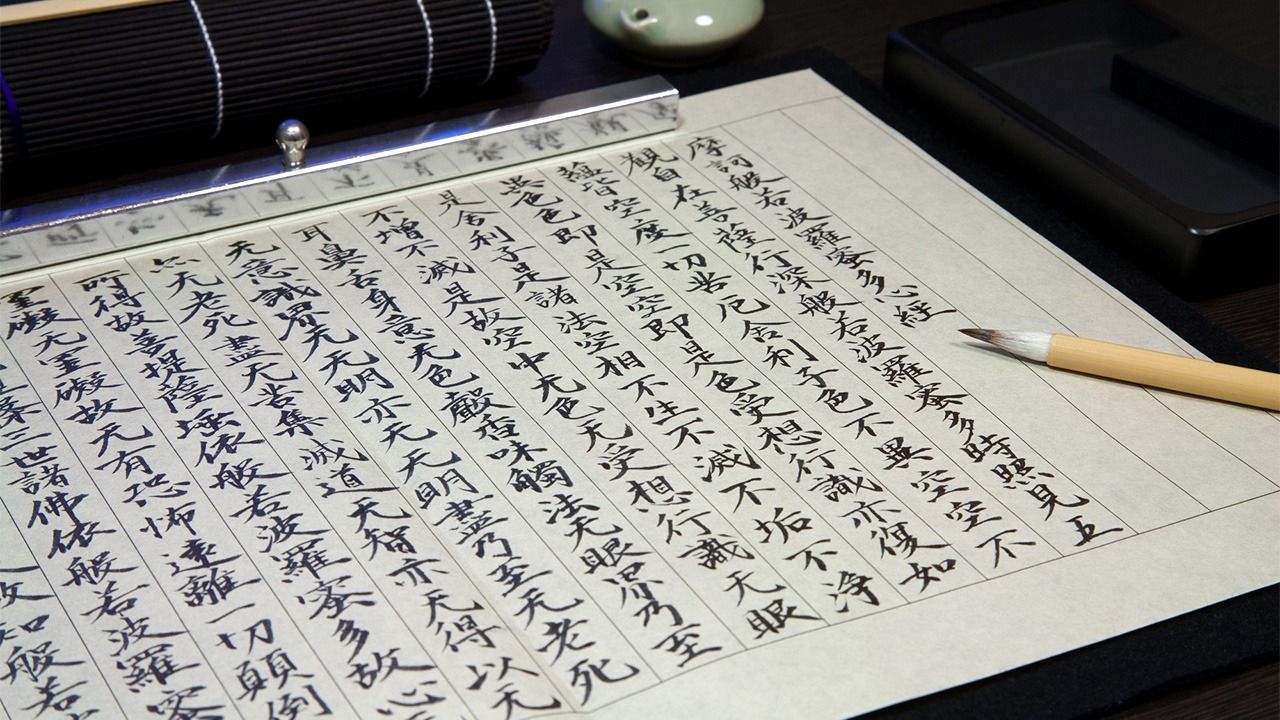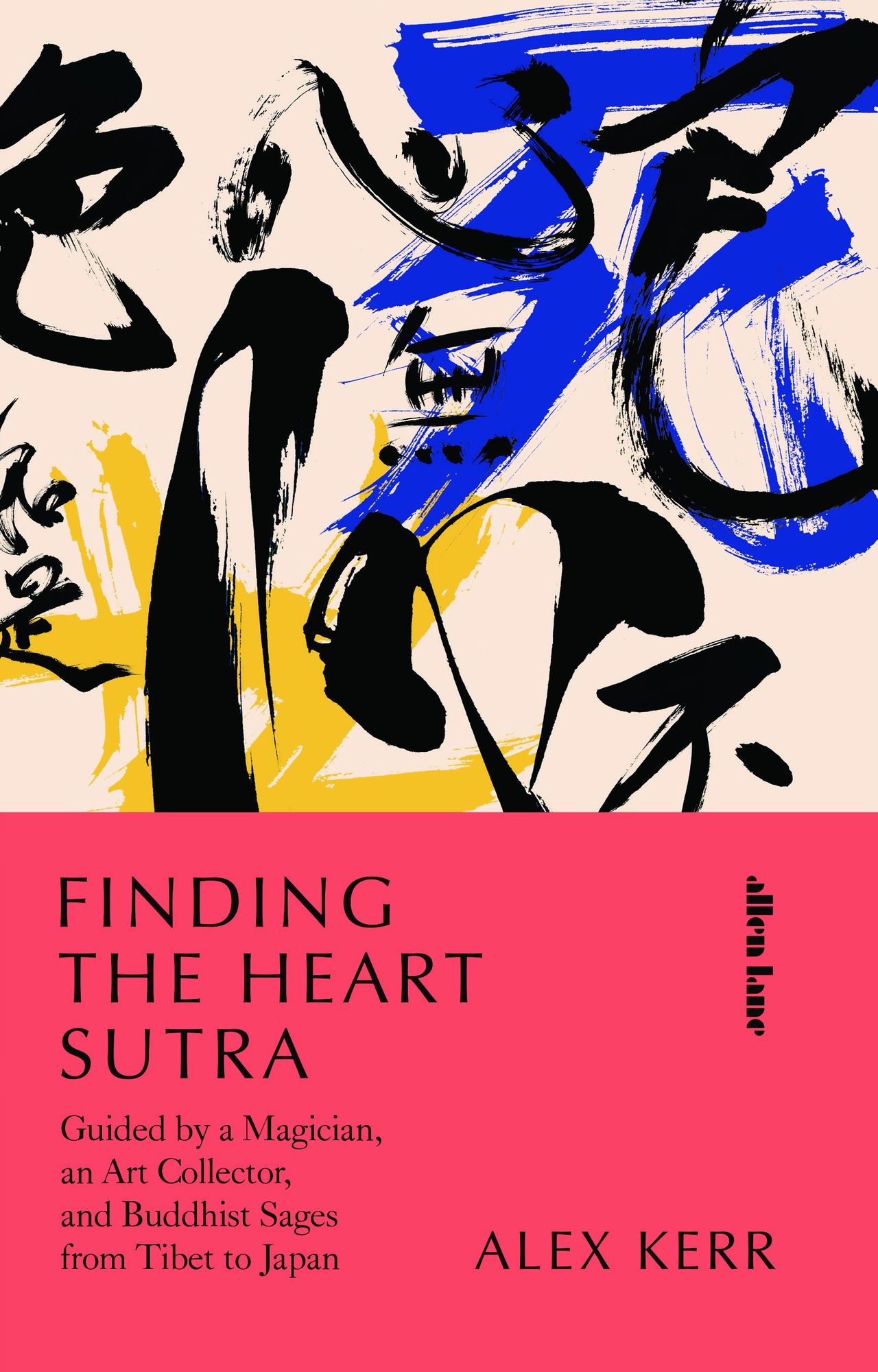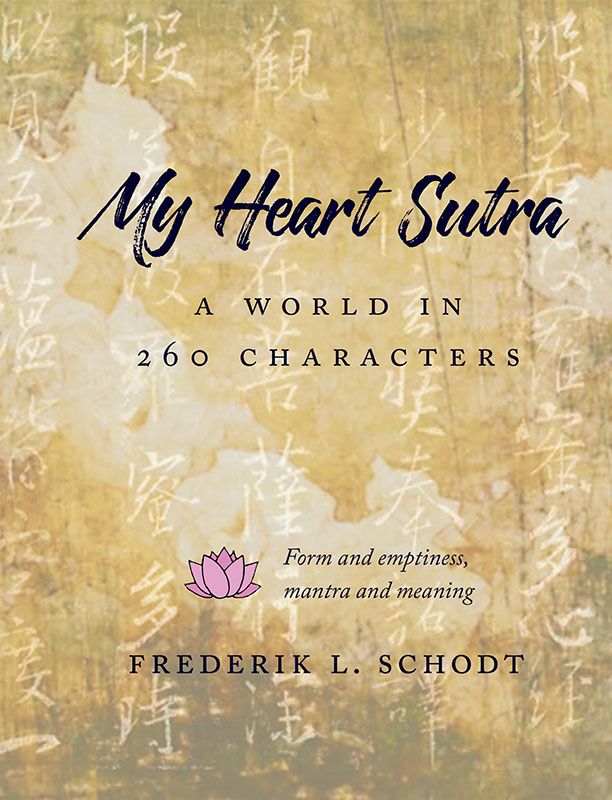
Two New Introductions to the Heart Sutra: An Ancient Text’s Relevance in Pandemic Times
Society Books- English
- 日本語
- 简体字
- 繁體字
- Français
- Español
- العربية
- Русский
Books Thirteen Centuries in the Making
The names Alex Kerr and Frederik L. Schodt are familiar to those who enjoy reading about Japan. Kerr’s books include Lost Japan (first published in Japanese in 1993 and English in 1996), a memoir of his time living in remote Shikoku exploring kabuki, art, and calligraphy, and the 2002 Dogs and Demons, a polemic addressing what he termed Japan’s “modern malaise.” He has also been deeply involved in promoting tourism to Japan and helping to preserve its traditional architecture.
Meanwhile, author and linguist Schodt is best known for his work on Japanese manga, starting with his 1993 Manga! Manga! The World of Japanese Comics and continuing on to his translation The Osamu Tezuka Story (2016). He has also penned books on robots and Japan’s early modern history. Yet, despite their very different resumes, something the writers share is a decades-long fascination—you might say obsession—with the Heart Sutra. This has resulted in two new books: Schodt’s My Heart Sutra: A World in 260 Characters and Kerr’s Finding the Heart Sutra.
Countless commentaries on the sutra, whose earliest extant versions date back to the seventh century CE, have been written over the years, but almost all by Buddhist scholars or practising Buddhists. Yet, for all Kerr and Schodt’s erudition and evident fascination with the sutra, neither are academics, Buddhist priests, or even Buddhists. And as the titles of their works suggest, while they differ in style, both books are deeply personal and aimed at the nonspecialist. It seems an almost cosmic coincidence that two such books on the sutra might appear in 2020.
Alex Kerr: A Mystery with Emptiness at Its Core
INTERVIEWER Two books coming out together seems such a coincidence. Has the Heart Sutra suddenly become topical?
ALEX KERR Well, I think it was always topical . . . every year there are probably ten new books on the Heart Sutra. It looks like it is suddenly a big subject, but actually it has been a big subject all along. Mostly the books tend to be by monks, priests—and then there is a lot of scholarly material out there.
INTERVIEWER Who did you write your book for?
KERR My public is not scholars, and it is not Buddhists, although I think Buddhists will get a lot from it, and scholars might as well. My ideal reader, as I see it, is someone who is interested in Asian wisdom, has a curiosity about Buddhism and about Asian philosophy, but is not an expert necessarily, or a devout convert.
INTERVIEWER Did you worry parts of the Heart Sutra might be difficult to explain to anyone unfamiliar with Buddhism?
KERR Pretty much all of it, right? The Heart Sutra is a bafflement and always has been. It is something that nobody will ever get their mind fully around unless they are the Buddha themselves. So, all we can do is approach it from different points of view which, by the way, brings in the other aspect, which is the relationship to one’s own life. And that’s also traditional. Many commentators have talked about that, and I did too. It’s interwoven with episodes in my own life that drew me to the Heart Sutra and made me think about the Heart Sutra . . . notably my mentors, David Kidd and William Gilkey. David Kidd was the glamorous materialist and William Gilkey was the ancient guru of spirituality. The two of them were actually close friends and loved each other, but they had absolutely diametric points of view.
Finding the Heart Sutra: Guided by a Magician, an Art Collector, and Buddhist Sages from Tibet to Japan
By Alex Kerr
Published by Allen Lane (November 2020)
ISBN: 978-0241468456
INTERVIEWER As well as Buddhist scholarship, your book touches on some very modern ideas, doesn’t it?
KERR Absolutely. My book draws plenty of parallels to mathematics, physics, and other fields, because we now know more about the universe, at least from a physical or mathematical point of view. That actually opens up huge insights on the core concept of the Heart Sutra, of course, which is emptiness. Emptiness makes a lot more sense now that we know there are no such things as atoms, electrons, and so on. There is just a sea of frothing possibility that’s fundamentally empty.
INTERVIEWER But I don’t think you mention the COVID-19 pandemic at all in the book.
KERR I finished the book mid-pandemic. I don’t mention the pandemic because I am not trying to be topical. Also, I began work on this thing close to forty years ago and began the actual writing about five or six years ago. It’s a much broader span. But I have to say that, personally, the pandemic sure brought home emptiness. Life has in many ways stopped, and that was a close-up meeting with the emptiness that I had seen theoretically.
INTERVIEWER Has the sutra provided solace?
KERR It has, yes. I quote Andy Warhol in there saying that the cure to all sadness is the words “So what?” That “So what?” is the cosmic “So what” of the great empty universe, in which we are nothing and don’t matter. And that’s the core idea, the original insight of Buddhism.
INTERVIEWER In your book you rather strikingly describe the sutra as “an engine of magic power.” Could you explain about that?
KERR This is where I diverge, I think, from most modern commentators. Classically, everyone understood that the sutra itself had magical power, and especially that the last four lines of the mantra at the end had the ability to change the world. And I believe that too.
INTERVIEWER In writing this book, did you find answers to any personal questions?
KERR There have been huge “aha!” moments. I am into mathematics and number theory. What we know about the big bang or chaos within numbers leads to very interesting thoughts about how you can start with nothing and end up with all this proliferation of stuff of the world that’s around us. And then of course there are the personal issues about what you do when you reach a stage in your life, you’re at a point, where you have suddenly come back to zero. Was it worth doing? Who are you?
INTERVIEWER So, the writing of the book was related to a stage in your life?
KERR Not exactly, because I started reading the Heart Sutra forty years ago. It’s almost the reverse. It’s as if I set out to write about emptiness and right around the time that it was completed—BAM!—emptiness showed up and knocked on the door. [Laughs]
INTERVIEWER Is there something in the sutra that still puzzles you?
KERR Yes, all of it! But the magical element will never cease to fascinate me. And, as I point out in the book, the Zen monks in Japan are emptying out their minds. But a Tibetan monk friend said, “What a bore, sitting in front of a wall and emptying your mind. We’re actually doing something!” Because from his point of view, Tibetan meditation was changing the world for the better.
That’s a very interesting concept that is also built into the Heart Sutra and again it raises these questions: “If it’s all empty, why bother doing anything?” “Why try to make the world better anyway?” It’s all a paradox. It’s all mystery. It never resolves itself. I will never stop puzzling over this.
Frederik L. Schodt: Form Is Emptiness, Emptiness Is Form
INTERVIEWER Why did you call your book My Heart Sutra?
FREDERIK L. SCHODT It is about my exploration of the Heart Sutra . . . an exploration of how I got interested in it and what it means. For me this is a very personal thing, and I don’t pretend to be the world’s authority on the Heart Sutra. I don’t get up at five in the morning and meditate every day, let’s put it that way. So, this is my story about what I’ve learned and what it means to me. I hope that it might resonate with people . . . that they might be inspired to learn a little bit more.
INTERVIEWER How did you first come across the Heart Sutra?
SCHODT I heard Allen Ginsberg recite it in Los Angeles in 1974. It was a period in my life when I was trying to figure out a lot of things. It just attracted me. But even before I heard Ginsberg recite it, in 1972 I had been taking a class on Buddhism and religion in South Asia at the University of California in Santa Barbara. While writing the book, I found some notes that I had from the class . . . it says somewhere in scrawled fashion, “This is all you need to know.”
The mantra portion became my “go to.” When I really needed to focus on something, I would often recite the mantra. Later, when I was on a plane flight from San Francisco to Los Angeles, the captain said that there were problems with one of the engines. At that point I start thinking, “Well, it’s time for me to calm myself a little bit, and really I should think about the Heart Sutra.” But I didn’t know how to recite the whole thing at that point.
My Heart Sutra: A World in 260 Characters
By Frederik L. Schodt
Published by Stone Bridge Press (December 2020)
ISBN: 978-1611720624
INTERVIEWER Did you always plan to write a book on the sutra?
SCHODT I had thought quite seriously about writing a book on it in 2006 or 2007, but that was on a much grander scale. In the interim, more books came out and I decided that I should just write something as a challenge to myself and for myself, to see if I could learn about it on my own. And that involved memorizing the whole thing and internalizing it.
The Heart Sutra is also a way for me to explore not only the sutra itself but what’s referred to often as the “emptiness theory,” which permeates Mahayana Buddhism in particular. The more I learned about it, I thought, “That’s very provocative, and it actually fits at least my modern view of the world and the importance of being able to deconstruct our realities.”
INTERVIEWER Are you talking about the famous assertation from the sutra: “Emptiness is form, and form is emptiness”?
SCHODT Yes, that’s just part of it. Now, I think most people who write about the Heart Sutra tend to focus on the emptiness theory, which is the intellectual component. Originally, I think the concentration was on the mantra and it had a talismanic appeal to it in China. It was more of a warding off evil, curing sickness, praying for better things, and so forth. But in English, it says that this is the “supreme mantra, the ultimate mantra.” That can also be translated as magic.
INTERVIEWER For those who don’t know the Heart Sutra, is there something in Western culture you could compare it to in terms of cultural importance?
SCHODT You could compare it to a prayer. In Christianity there is the Lord’s Prayer. When your plane is going down, what do you use? If you are a Muslim, there is something you can probably pull out of a mental drawer and recite it to straighten your mind and gain courage, strength, some sort of clarity.
INTERVIEWER How did being a linguist help you with this book?
It obviously helped me a lot. I am fairly bilingual in English and Japanese, and that helped doing interviews in Japan and connecting with monks and scholars. Even though I’m not an expert on Chinese, there is obviously an overlap in terms of the writing systems. And my wife is Chinese. So, I am also interested in China, and especially that era. If I was to be reborn in China, I would love to be in the Tang Dynasty. [Laughs] I have also travelled quite a bit in China and I am always looking out for the Heart Sutra or anything to do with it. I like stuff, physical things. In this little space here at home, I have tons of Heart Sutra books, cups with the Heart Sutra on them. I am wearing a Heart Sutra ring. It’s got all 260 characters inscribed on it.
INTERVIEWER You write a lot about the seventh-century scholar and translator Xuanzang, who traditionally is said to have brought the Heart Sutra from India.
SCHODT I’m in awe of the man. His travel to India is quite well documented. There are archaeologists and historians of Buddhism who have gone to India and have been able to confirm many of the things that are in his report that he wrote for the emperor on his return. It’s also fascinating to read how some of the early twentieth-century explorers were devoted to Xuanzang as well.
INTERVIEWER But you also focus quite closely on the debate about the authenticity of Xuanzang’s “translation.”
SCHODT Professor and scholar Jan Nattier wrote a thesis about the Heart Sutra perhaps being an apocryphal sutra, in the sense that it may have not been created in India. Her thesis, which was written back in the 1990s, became quite controversial. In Japan, the idea that the Heart Sutra may have been compiled in China first is still kind of a delicate area; even scholars are inclined to think that of course it came from India. Most scholars in the West, at least, regard the sutra as having been compiled in China, but it may have incorporated elements of other sutras that were more directly imported from India.
The Buddhist tradition is so long and so deep in Japan that you get into much more resistance if you try and say that a sacred sutra may not have been the exact words of Buddha or may not have actually emanated from India, even. Or to say that, actually, the Sanskrit version was back-translated from Chinese, which is one thing that Nattier has suggested.
I was just personally fascinated by this debate that has roiled academia and Buddhist studies ever since Nattier came out with her paper. But nothing is established 100 percent, because there is always room for somebody to find a lost text in the desert somewhere like Xinjiang that has a completely different take on this.
INTERVIEWER Do you have any advice for those who want to explore the Heart Sutra?
SCHODT You can go on YouTube now and you can hear people chanting in Japanese, Chinese, Burmese, all over the world. I’m quite fascinated by the chanting. There is a rhythmical quality that you can achieve with the Heart Sutra because it is short and it’s not as complicated as a lot of Buddhist sutras. There is a monk in Japan who has these fabulous videos of himself chanting the Heart Sutra at various temples in Japan. His name is Yakushiji Kanhō. I highly recommend looking him up.
INTERVIEWER Has the Heart Sutra helped you during the pandemic?
SCHODT I definitely think that the emptiness theory can help us see that what we perceive is filtered through our senses. As the Heart Sutra says, “no eyes, no ears . . .” It goes through these negations, which helps us realize that we are so dependent on our own physical bodies to interpret reality. The Heart Sutra makes me think about the fact that there are other ways to think about reality. There’s more to life than a pandemic. There’s more to life than whatever suffering—which is real—we perceive. There are other things, there are other layers. And, in that sense, it has been very helpful to me during the pandemic.
(Originally written in English; interviews by Tony McNicol. Banner photo © Pixta.)

